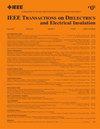Lifespan Evaluation of HTV Silicone Rubber in Outdoor Composite Insulators Considering Temperature Cycling and Corona Discharge
IF 3.1
3区 工程技术
Q2 ENGINEERING, ELECTRICAL & ELECTRONIC
IEEE Transactions on Dielectrics and Electrical Insulation
Pub Date : 2025-03-06
DOI:10.1109/TDEI.2025.3567210
引用次数: 0
Abstract
The reliability of high-voltage overhead lines is strongly correlated to the status of outdoor insulators, which is correlated to the condition of high-temperature vulcanized silicone rubber (HTV-SR) used as insulator sheds. Current research pays attention to HTV-SR’s degradation under different environmental stresses (e.g., temperature and corona discharge). However, the lifetime assessment of the aged HTV-SR is unclear, and the effect of temperature cycling is seldom considered. In this study, a remaining useful lifetime (RUL) prediction method for HTV-SR is proposed, which considers both temperature cycling and corona discharge. Accelerated lifetime tests of HTV-SR are conducted, and the key parameters of the model are determined by the experimental data. Thus, a formula for quantitative RUL prediction is put forward, which indicates that when the cyclic temperature is考虑温度循环和电晕放电的HTV硅橡胶室外复合绝缘子寿命评价
高压架空线路的可靠性与室外绝缘子的状态密切相关,而室外绝缘子的状态又与高温硫化硅橡胶(hhtv - sr)用作绝缘子棚的状况有关。目前的研究重点是HTV-SR在不同环境应力(如温度和电晕放电)下的降解。然而,对HTV-SR的寿命评估尚不明确,且很少考虑温度循环的影响。在本研究中,提出了一种同时考虑温度循环和电晕放电的HTV-SR剩余使用寿命预测方法。对HTV-SR进行了加速寿命试验,并根据试验数据确定了模型的关键参数。由此,提出了RUL定量预测公式,当循环温度为$5.5~^{\circ}$ C $ sim为21.3~^{\circ}$ C,样品表面电场强度为4.5和6.8 kV/cm时,RUL的可靠性分别为25.9和8.4年。利用不同运行次数的现场老化绝缘子断裂伸长率对预测模型进行了验证。本研究提供了一种估算HTV-SR材料RUL的方法,可以指导输电线路室外绝缘子的维护。
本文章由计算机程序翻译,如有差异,请以英文原文为准。
求助全文
约1分钟内获得全文
求助全文
来源期刊
CiteScore
6.00
自引率
22.60%
发文量
309
审稿时长
5.2 months
期刊介绍:
Topics that are concerned with dielectric phenomena and measurements, with development and characterization of gaseous, vacuum, liquid and solid electrical insulating materials and systems; and with utilization of these materials in circuits and systems under condition of use.

 求助内容:
求助内容: 应助结果提醒方式:
应助结果提醒方式:


